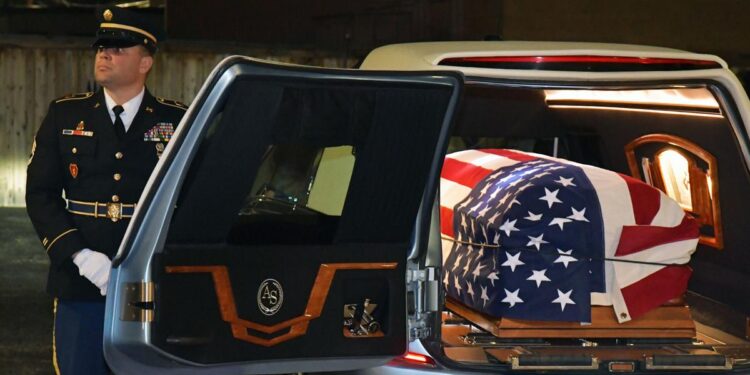Homer Mitchell was a people person, someone you would want to share a laugh with and someone who never met a stranger.
Pvt. Homer Mitchell was 20 years old when he was killed in a forest in western Germany while he and fellow soldiers were being hammered with heavy artillery December 1944, thousands of miles from home. It was a death that came less than six months after Mitchell survived the amphibious landing at Utah Beach.
Mitchell will be six months shy of his 100th birthday when his cremains are buried at his mother’s feet in the cemetery in Portales, N.M., almost 80 years after his mother was notified her son had died in combat but his remains couldn’t be recovered.
The burial comes courtesy of the Defense POW/MIA Accounting Agency, a governmental agency dedicated to identifying the remains of those who died in battle by using advances in DNA technology. Pvt. Mitchell’s remains were formally identified on July 24, 2023, said Bill Davis, a longtime Lawton resident who is Mitchell’s oldest nephew.
“He was well liked and a talker. And he had a way about him,” Davis said about the memories and stories he has of his uncle, adding that “way” extended to the ladies.
“He loved the ladies.” Davis said with a laugh. “He was handsome. He was a hard worker. And, he made friends and he never met a stranger.”
At 82, Davis is the only family member left who actually met Mitchell, and his personal memories are those of a young child remembering his teen-aged uncle (although he has a photograph of himself as a child, sitting on his uncle’s lap). The memory of the pain his grandmother suffered is clearer, Davis said, explaining she mourned her sons’s death and the fact his body was never recovered.
“She had no use for Germans. They were the ones who killed her son. I had to tell her: It could have been anyone,” Davis said, speaking from the perspective of a soldier himself who has witnessed the damage artillery can do.
Davis said his own mother also felt the loss deeply. She had been close to her brother, the next to youngest in the Mitchell family.
To say Davis was surprised by the news of his uncle’s identification is an understatement.
“When I got the call in July, I hung up on him,” Davis said of the official notification from the Defense POW/MIA Accounting Agency (DPAA), adding he told the caller “You are a scammer.”
Davis said he got to thinking about the call and called the man back, apologized, then asked for details. What he heard astonished him. Davis learned that DNA provided by one of his female cousins allowed the DPAA to identify a set of bones as belonging to his uncle. And Davis, as Mitchell’s oldest living direct descendant, was designated the next of kin, charged with the decisions about what would be done with the body.
Davis said he needed time to think about it, something his wife also urged him to do.
“I was never prepared for this. Not in my wildest dreams did I think that day would come,” he said, of his uncle’s return home.
Davis’ final decision was made with his grandmother in mind, so she could have her son back. That’s why Mitchell’s remains are being cremated.
“The plot is full. We never expected to get his remains,” Davis said, adding that fact changed 79 years after his uncle’s death. He received permission from the cemetery to inter the urn at his mother’s feet so he can be with his parents and three of his brothers.
The funeral is set April 26 in Portales, where Mitchell lived until he joined the Army in 1943. His remains will be transported to Oklahoma City on Friday via Southwest Airlines, flying from their storage area in Omaha, Nebraska, to Houston, then to Oklahoma City. Once in Oklahoma, the remains will be transported to Lawton, where Becker-Rabon Funeral Home will handle the cremation in preparation for transport to Portales.
The battle that killed his uncle was fierce, Davis said, reading from the military report that said Pvt. Mitchell and his comrades crossed the Saar River in western Germany to get to the forest where they dug their foxholes and engaged the enemy.
“They were heavily attacked,” he said.
The wounds that killed his uncle are evident on the skeleton, Davis said, explaining the bones on the body’s right side still hold shrapnel. What’s amazing, even to a military analyst used to working with remains, is the fact that Mitchell’s skeleton is mostly intact, with the few missing bones mostly in his feet and hands.
“He said he’d never seen a skeleton that well preserved,” Davis said, adding he has seen pictures of the body and was astonished at how much had been recovered and the wounds his uncle suffered.
“He was a hero.”
Want to reach a local audience and grow your business?
Our website is the perfect platform to connect with engaged readers in your local area.
Whether you're looking for banner ads, sponsored content, or custom promotions, we can tailor a package to meet your needs.
Contact us today to learn more about advertising opportunities!
CONTACT US NOW





